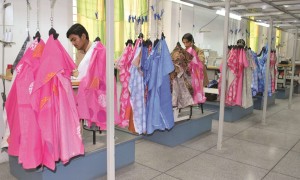Knowledge Transfer to Drive Cotton and Textile Growth

Cotton is a fiber of trust, and it imparts a sense of prestige. The Indus valley civilization, which began more than 4,000 years ago, is considered by many to be the birthplace of cotton. The earliest historical evidence of cotton was found there, just south of the Himalayan Mountains in what is known today as Pakistan and northeast India.
Since 2,300 BC, this part of the world has been a stronghold for the natural fiber. To this day, it remains an important non-food cash crop and a significant source of foreign exchange earnings. Cotton accounts for 7.5% of the value added in agriculture and accounts for about 2% of Pakistan’s gross domestic product (GDP). Cotton is the country’s main cash crop, and it ultimately supports 65% of the national GDP through the textile and subordinate industries and their exports.
Because the textile industry remains the main engine behind the growth of the Pakistani rural and urban economies, it’s a good time for all stakeholders to revisit the importance of the cotton crop in Pakistan and its short- and long-term socioeconomic and political impact. Currently, Pakistan’s industrial sector accounts for about 26% of national GDP. Cotton textile production and apparel manufacturing are Pakistan’s largest industries, accounting for about 66% of the merchandise exports and nearly 40% of the employed labor force. Cotton and cotton-based products account for 61% of export earnings of Pakistan.
Cotton remains a scattered subject between federal and provincial institutions in Pakistan. The recently strengthened Ministry of Textiles, part of the Ministry of Food and Agriculture (MINFAL), is trying to achieve the objectives set by their predecessors – including Cotton Vision 2015 – a long-term strategy to increase the production of cotton in Pakistan to 20 million bales by 2015 – and strengthen the economic structure around this commodity. Overall, Pakistan’s textile sector is very strong in spun yarn and weaving, but quality standards and efficiency remain questionable.
Over the past few years, production and consumption of cotton has increased significantly. However, this growth is not equal to that of its two core neighboring and competing markets: China and India.
Over the past few decades, Pakistan has invested heavily to enhance its textile production output and economic value; however, the basic sectors of seed breeding and ginning have been largely neglected at both public and private levels. Currently, Pakistan faces challenges of low yields at the production level, higher indirect supply-chain management losses of fiber during processing, and low value-addition to the end product.
However, it’s the shortage of electricity that poses the biggest hurdle to Pakistan’s textile industry, lowering output and increasing inefficiencies along the entire cotton and textile supply chain.
As a result, there is an immediate need to develop a positive and realistic cotton-production policy – one that will focus on achieving higher output at farms and narrowing the gap between the yields produced large-scale and small-scale farmers. The idea is to encourage knowledge transfer through farmer participation programs, such as creating of farmer associations in small villages to solve problems as a community, and providing micro-financing to them on terms they can live with.
The development of good domestic seed institutions, as well as allowing international seed firms to invest in Pakistan’s agriculture sector, will ensure the long-term supply and development of pure, certified cotton seeds. The spurious and low-yielding seeds that clog the Pakistani market should be banned. Efficient farm-management techniques must be developed and disseminated, and better management practices at all levels of the supply chain must be promoted. This will ultimately lead to the creation of better jobs at all levels of the cotton and textile supply chain.
A number of initiatives have been undertaken by both the private and public sectors, but those two groups don’t always communicate effectively. The government is trying to remedy that communication gap and has restructured its central cotton committee, the Pakistan Central Cotton Committee (PCCC), which is the nation’s primary organization for research & development in cotton, and disseminator of the resulting information. PCCC is working to engage people from four areas: ministry officials, textile manufacturers, ginners and traders. But they still lack the necessary representation and input from the grower community.
Overall, the state of textile and cotton industry in Pakistan has been progressively improving in recent years, but the ratio of growth-to-time remains nominal – and compared to our regional and global competitors it has been virtually negligible.
As the fourth-largest lint producing country in the world, Pakistan and its government officials need to review and improve their policies in all segments affecting this commodity. All stakeholders in the cotton and textile supply chain need a comprehensive and realistic plan to elevate the country’s textile industry and achieve the kind of growth exhibited by its neighbors, China and India, over the last decade.









